Hermès Watch Straps: Quality Without Compromise, Suppleness Guaranteed
In the recently published book Breguet, The Story of a Passion 1973 – 1987, Breguet’s general manager François Bodet writes that in 1975 and 1976 he “targeted jewelry rather than watchmaking clients” for the newly re-created Breguet brand that the Chaumet brothers had entrusted him with.
One of the ways he made these timepieces more attractive to cultured Europeans at the time was to create an identification bridge between mechanical watchmaking and Parisian luxury.
“I equipped the Breguet watches made in Paris with Hermès leather straps – a strategic alliance in which the well-known prestige of this brand implicitly signified that of Breguet. Mechanical watchmaking thereby identified with Parisian luxury,” Bodet wrote.
Breguet, The Story of a Passion 1973 – 1987 presents an interesting insider case study on how a Swiss luxury brand was created in the 1970s . . . just as mechanical watchmaking was on its way out.
But almost even more interesting for me as seen from the present-day was the unexpected mention of Hermès’ straps in this context.
A historical happenstance
Hermès, which founded its own watch factory in Brügg, Switzerland (near Biel) in 1978, has been famous for its leather products – which began with saddlery – since its inception.
Its own enthusiasm for the world of watchmaking was perhaps aroused thanks to Jacqueline Hermès’ interest in watches as documented in 1912.
The story goes that young Jacqueline Hermès, a third-generation member of the Hermès family (founder Thierry Hermès’ granddaughter), disliked the way she had to carry her small pocket watch; it was not “handy” enough for her active leisure activities. She thus asked her father to encase it in a leather “pocket” that would allow her to strap it to her wrist.
She was practically ahead of the fashion for the time by choosing to wear it on her wrist.
Though the company began making saddle-stitched leather straps eight years later, in the 1920s, it wasn’t until 1928 that the first watch signed by Hermès (and powered by a Movado movement) was available. Naturally, the leather “case” of this automatic pocket watch was crafted in Hermès’ famous skin.
In-house strap production
The La Montre Hermès factory has something that no other watch brand can boast: its own in-house strap production.
The leather strap workshop was added to the purpose-built factory resembling the headquarters in Paris (complete with the little horse rider on the roof) in October 2009.
An airy place, the strap-making process can hardly be called industrial; I would describe it as artisanal.
The movements used today – including Hermès’ own Caliber H1837 – are manufactured by Vaucher, in which Hermès owns a 25 percent stake. Parmigiani Fleurier also owns a stake in Vaucher.
Currently, Parmigiani is the only other mechanical watch brand with the honor of offering the luxurious Hermès leather straps for its watches. The digital Hermès Apple watch is also equipped with them.
Leather-working process
The section of La Montre Hermès, which is outfitted with large ground-level windows and a very friendly atmosphere, has a much different feel to it than the rest of the factory dedicated to the tasks needed to complete the metal parts of a wristwatch.
Instead of watchmakers dressed in white lab coats and wearing determined expressions of concentration on their faces, the strap makers are colorfully fashionable.
A total of 13 craftspeople work in the leather workshop in Brügg. A team first prepares, precuts, and pairs the leathers sourced from hindquarter calfskin leather. The cutting is accomplished by use of a large hydraulic machine, which the artisan controls by pressing two buttons with the thumbs.
When I visited the workshop a few years ago, I had the opportunity to aid in making my own strap, which is black Barenia calfskin. The strap lining, beige in color, is a special leather that Hermès calls “Zermatt,” which is additionally tanned with a special treatment to prevent possible allergic reactions.
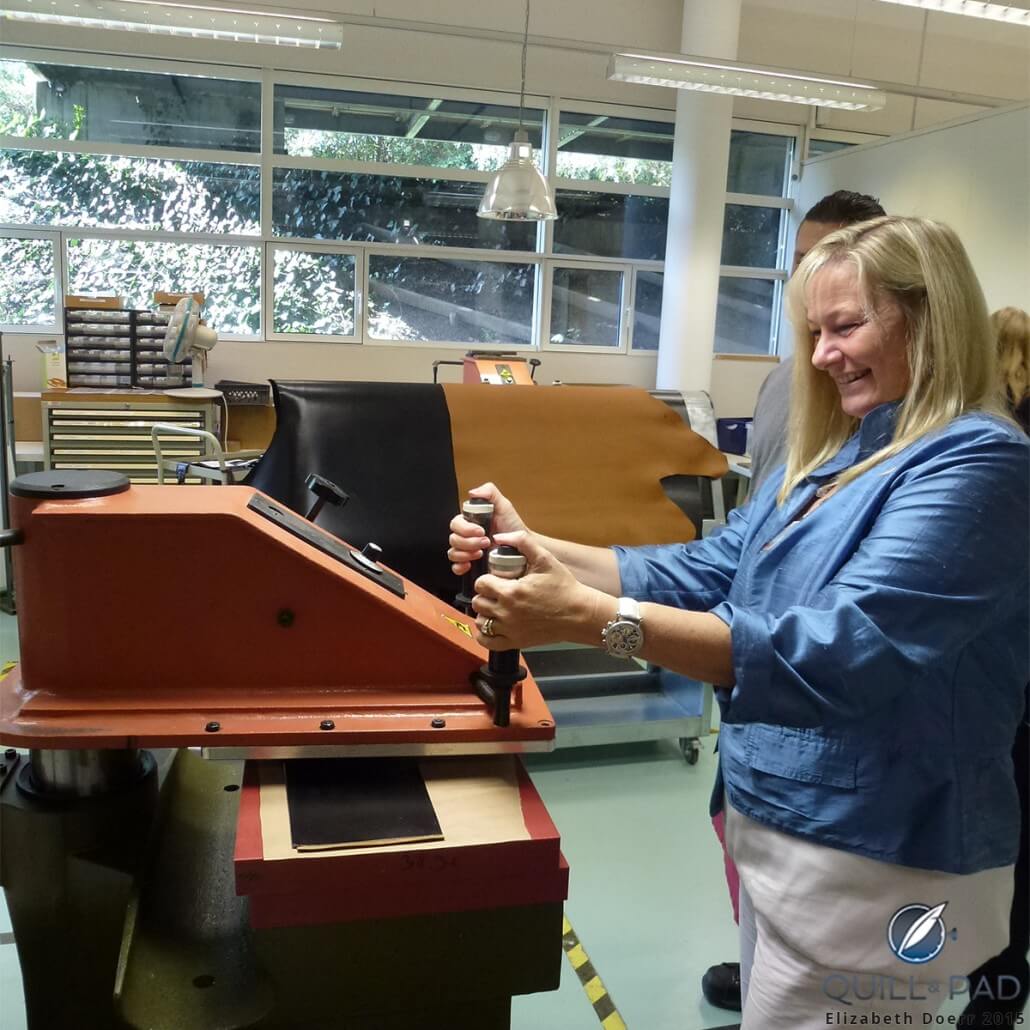
The author takes a turn at cutting out the strap shapes from the pre-cut leather for a Hermés watch strap
The artisan took over the process of gluing the pieces together (too tricky for a novice!), which included inserting a thin sheet of paper between the layers. He also traced the proper holes for the stitching, which makes the seamstresses’ work (and mine) marginally easier in the next step.
Hermès leather
While the glue dried, I followed my hosts to the temperature-controlled room where the leathers are kept to learn more about this veritable rainbow of natural skins.
Hermès’ watch straps are generally calfskin from two-to-three-month-old cows; this skin is a byproduct of the meat industry. The strong Barenia calfskin Hermès uses is available in three colors.
We naturally also think of alligator skin when we think of Hermès leather, which is available in both matte and glossy finishes. The shiny variant is not varnished, but instead polished with a semi-precious agate stone.
The leather – worked in Hermès’ Italian tannery and supplied by a farm in Mississippi – comes from the belly of the animal, one of which can only supply five straps. The rest is not wasted, but rather donated to art schools.
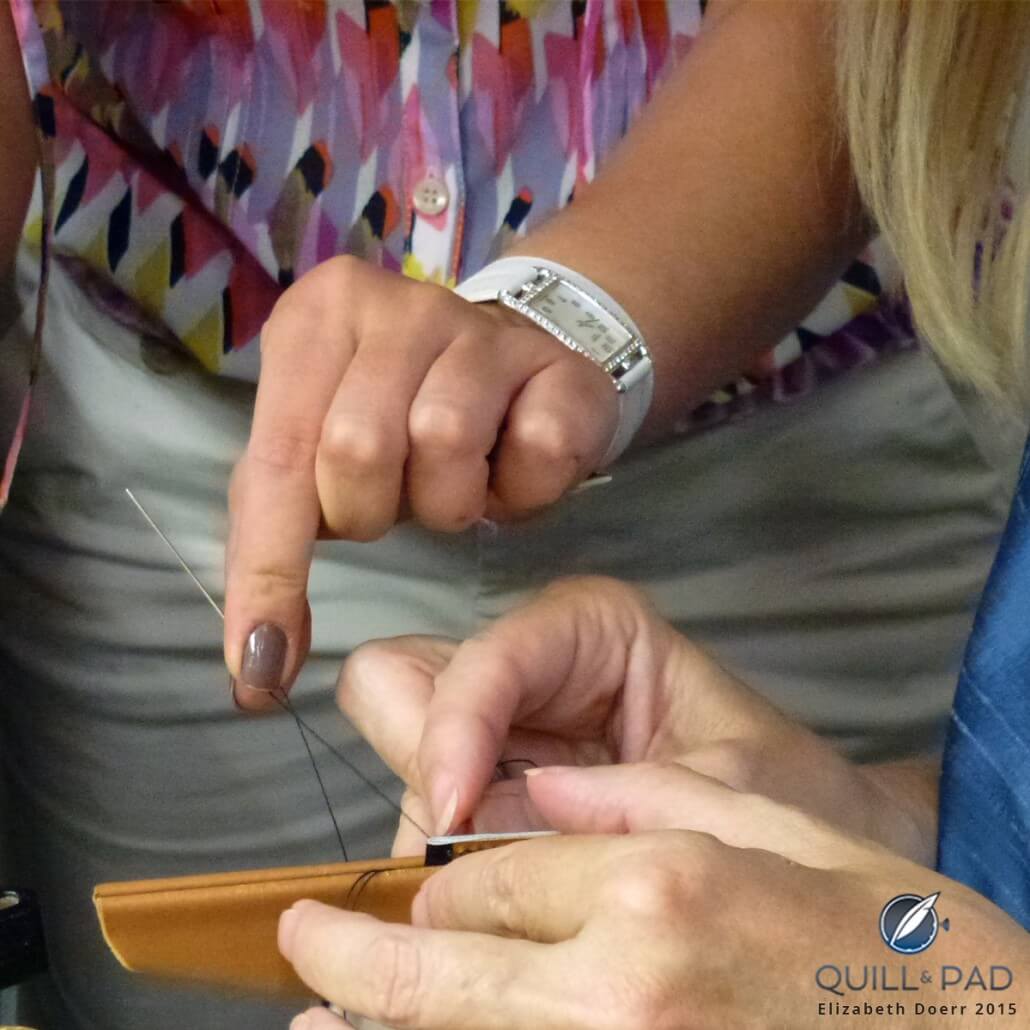
The author carefully stitches the Hermès calfskin strap together under the watchful eye of a seamstress
Sewing
Six seamstresses sew the pieces together using the brand’s world-famous slanted saddle stitch. Each can only make eight straps per day, although Hermès will fulfill additional special orders, which are crafted by artisans in the Paris workshop.
Using flaxen thread and two needles, I was shown how to do the saddle stitch on my own future strap on the folded ends of the pieces.
Though I am not a stranger to sewing, it was not easy, but delicate, exacting, precision work.
What seemed like years later, I had completed the stitches and my “teacher” (an Hermès artisan) fixed them in place with a dab of glue. Then we applied black dye to the sides of the leather strap to make the color uniform, after which we fixed the dye in place by heating it.
Now that the leather was warm, we softened the edges of the strap by rubbing and sandpapering, which also provided the correct thickness and quality.
Using a hot steel iron (whose application looked much like beveling to me) and a hammer, we then matted the leather and smoothed out any imperfections before applying some beeswax, which protects the strap from humidity and sweat.
The most intricate work takes place when the seamstresses sew the two loops holding the strap in place, one of which is fixed and one of which is movable. This particular step requires great experience, skill and patience – and a trained hand.
Cutting, gluing, heating, and hammering is done just like with the main strap pieces, but on a much, much smaller scale. The holes made by a tool that looks like a fork are, however, so small that the artisan actually can’t see them and thus she sews by feel alone.
Once all of these processes have been successfully accomplished, the artisan inserts a heated steel rod into the folded end of the strap to ensure space for the spring bar that will be added to attach the strap to a case.
When all is said and done, the finished strap – which has needed one hour alone with the seamstress (when she isn’t teaching a beginner) – undergoes quality control checking, after which it is stamped with the appropriate marks denoting year and brand.
For more information, please visit www.hermes.com.
Trackbacks & Pingbacks
-
[…] See how an Hermès strap is made in Hermès Watch Straps: Quality Without Compromise, Suppleness Guaranteed. […]
-
[…] See how an Hermès strap is made in Hermès Watch Straps: Quality Without Compromise, Suppleness Guaranteed. […]
-
[…] It’s Saturday, so that means it’s time for another edition of Watching the Web. Here, we highlight interesting articles we come across on other sites, as well as identify which of our own recent articles were the most popular over the last week or so. For this week, we have some high-end Hermes straps, a hand-engraved Rolex Milgauss, and a new rounded-off Trintec Zulu. From our pages, it’s the Matt show, with his posts on the Lew & Huey Phantom, Chronos Wearable, and Top 5 Picks articles taking the top honors.We have featured a variety of watch strap reviews over the years, all solidly in the affordable end of the spectrum. What about straps that would be solidly attached to luxury watches, perhaps something from a well-known brand like Hermes? Well, over at Quill & Pad, Elizabeth Doerr visited their strap-making facility and made her own. Check that out right here. […]
Leave a Reply
Want to join the discussion?Feel free to contribute!

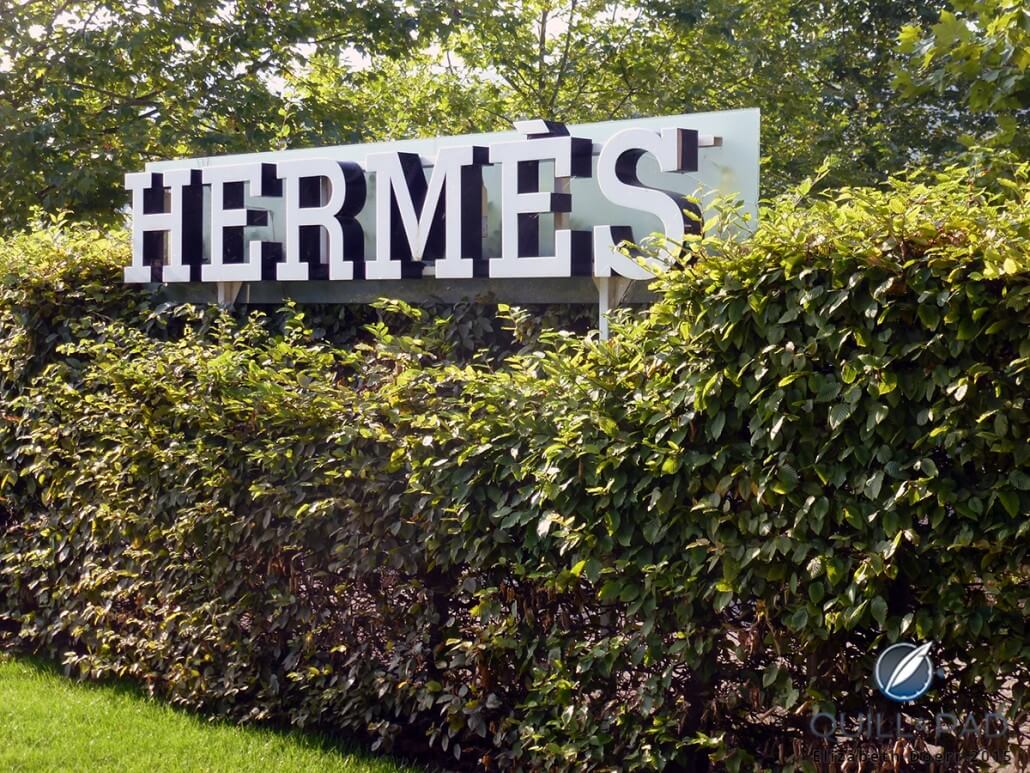
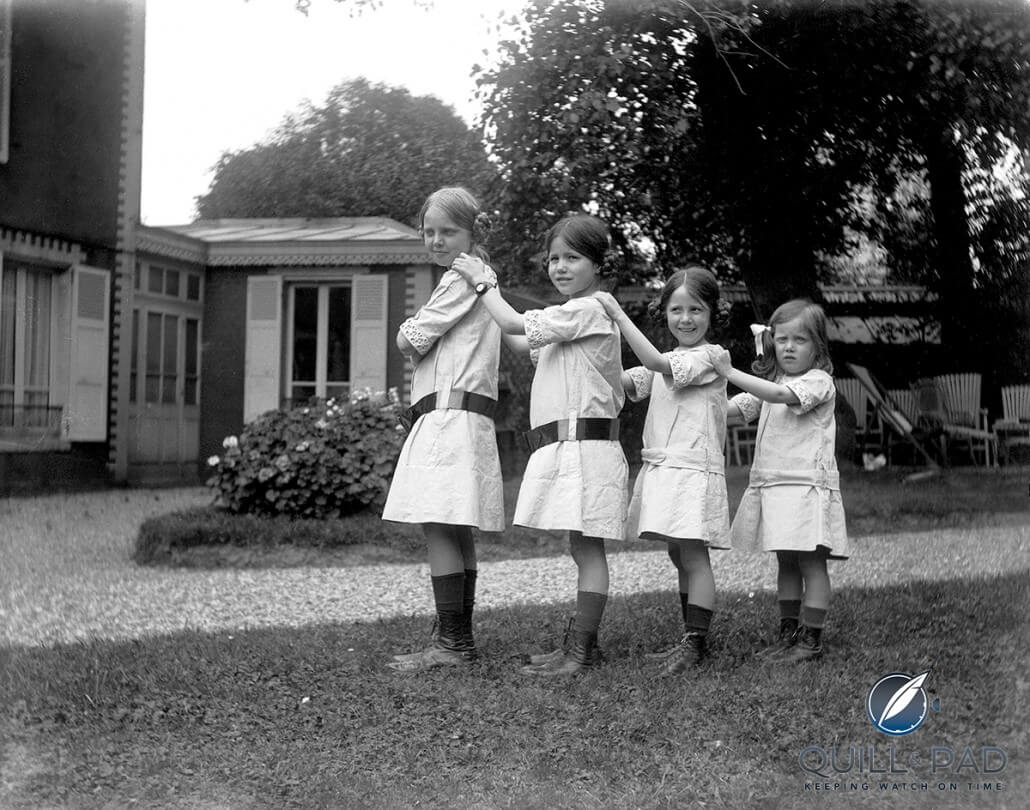
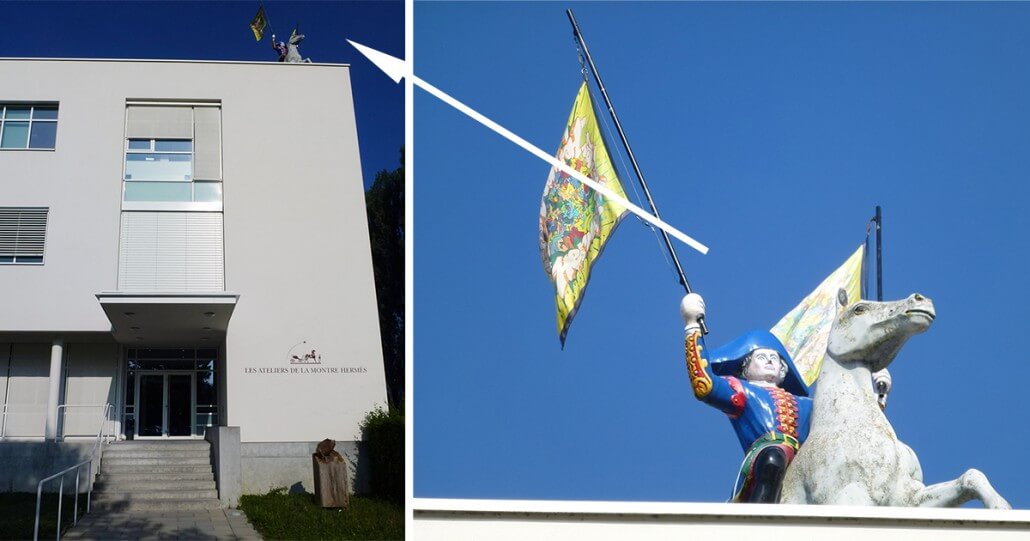
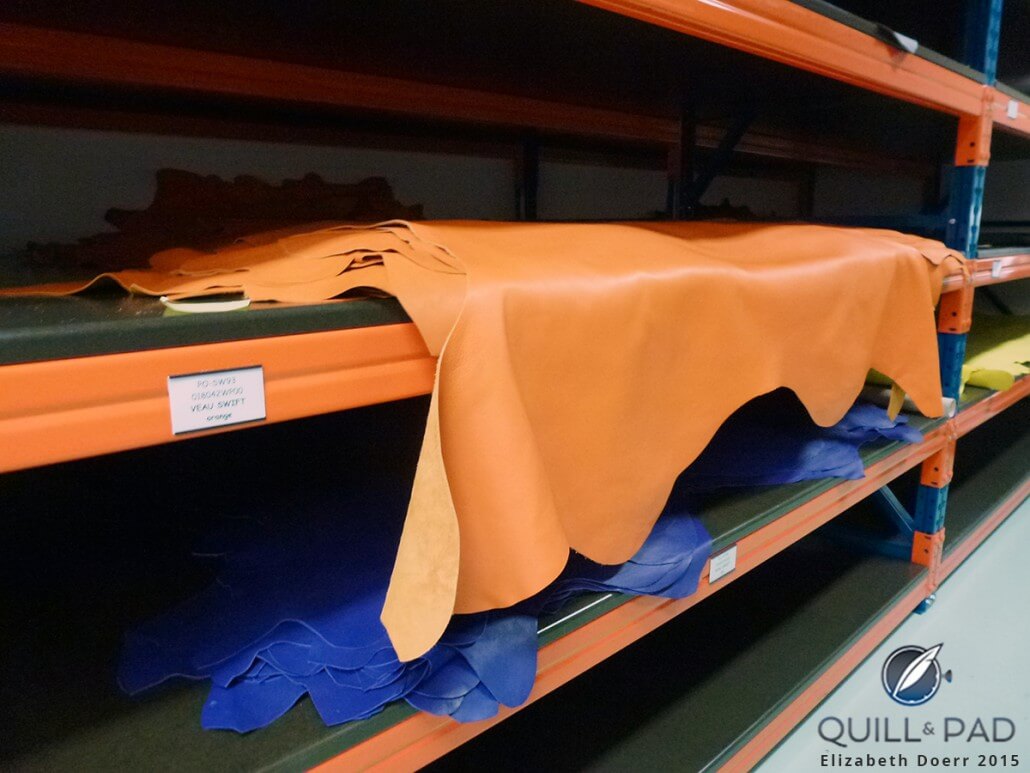
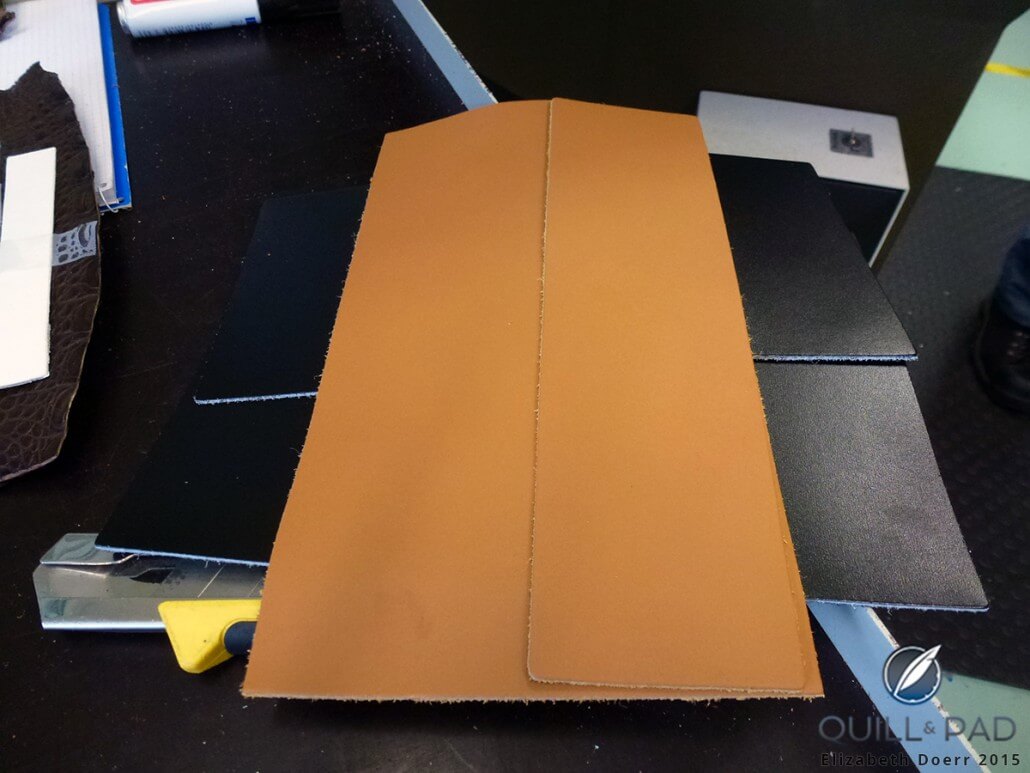
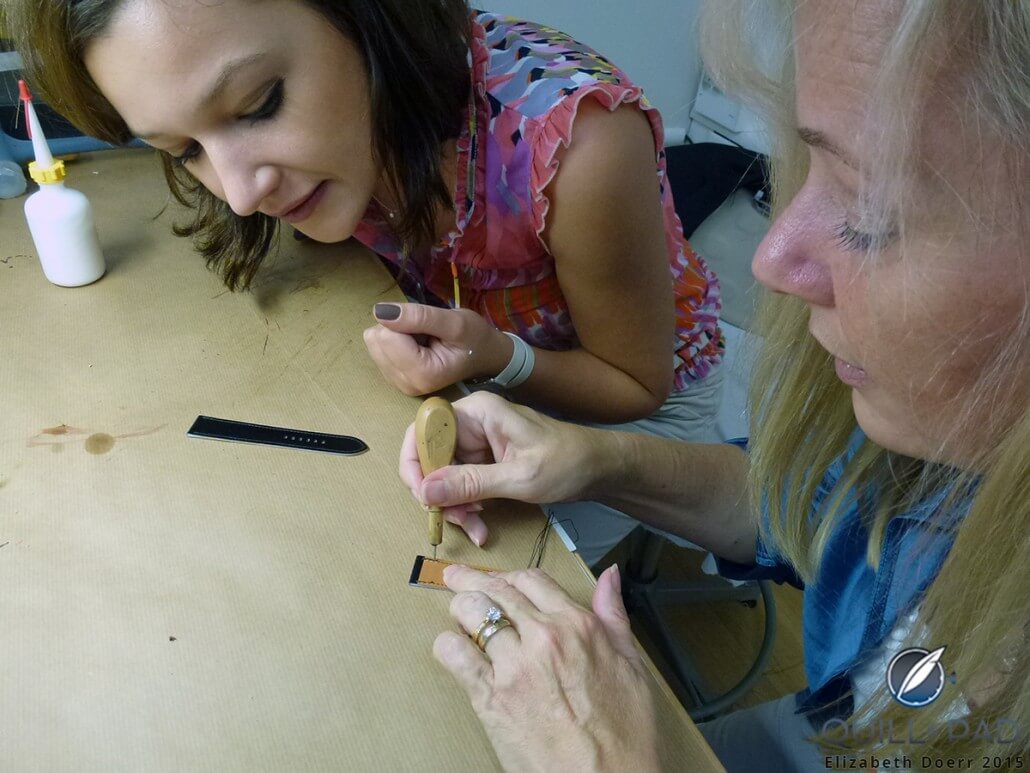
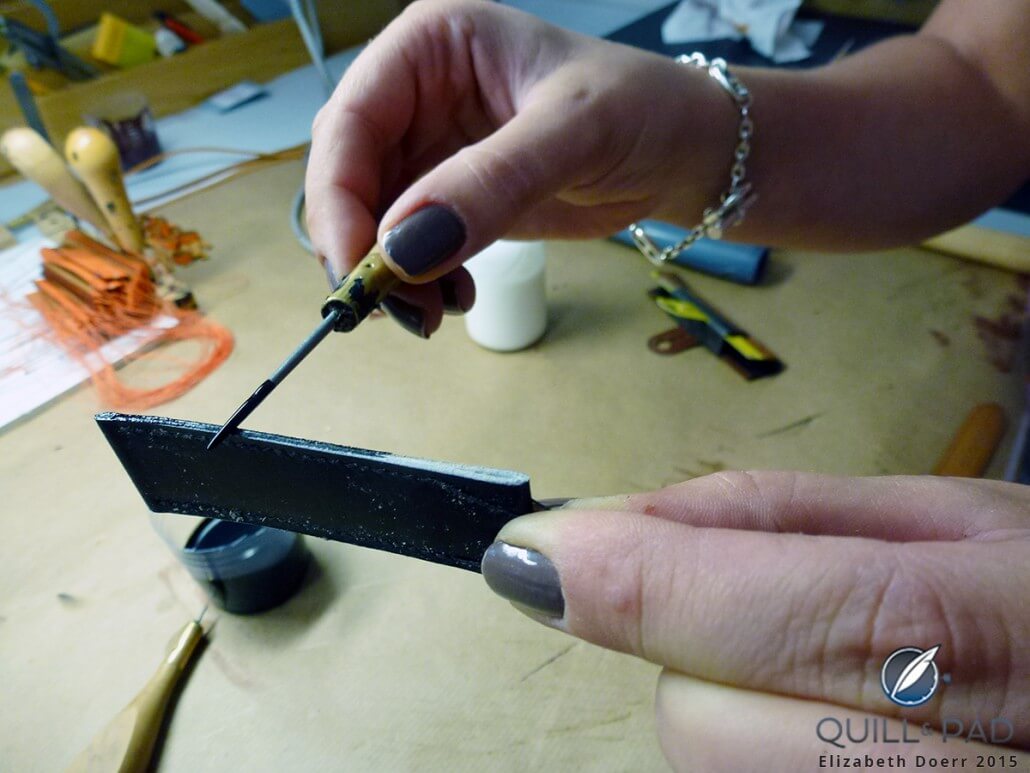
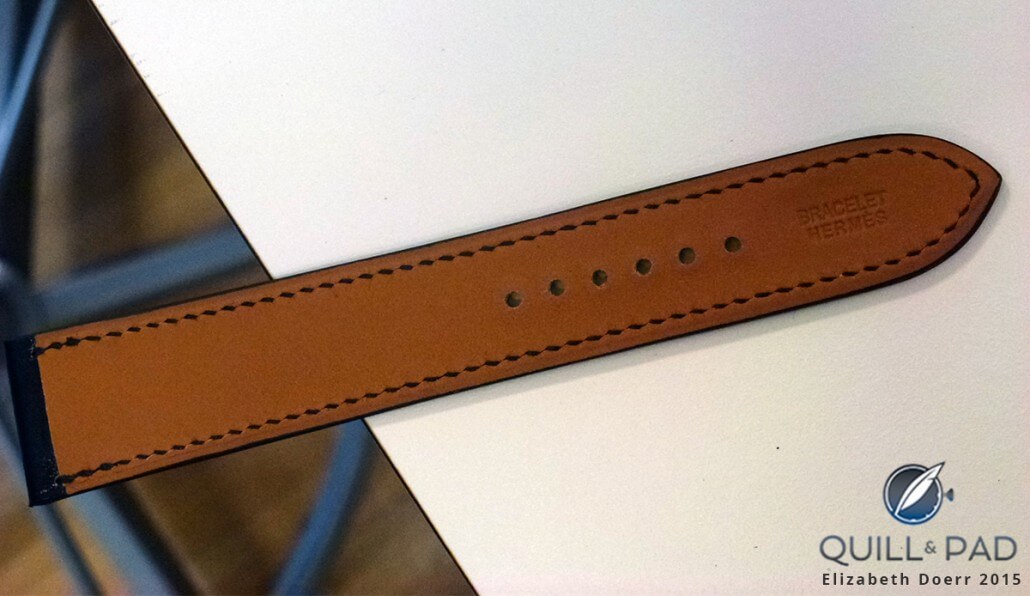


It’s quite impressive seeing just how much effort goes into these higher quality watch straps. Love being able to get a behind the scenes look at what goes on.
Great Blog. I am very happy to read this blog. This blog clearly explain that how much effort are made to create these watch straps. I am totally impressed. https://www.evolvewatches.com